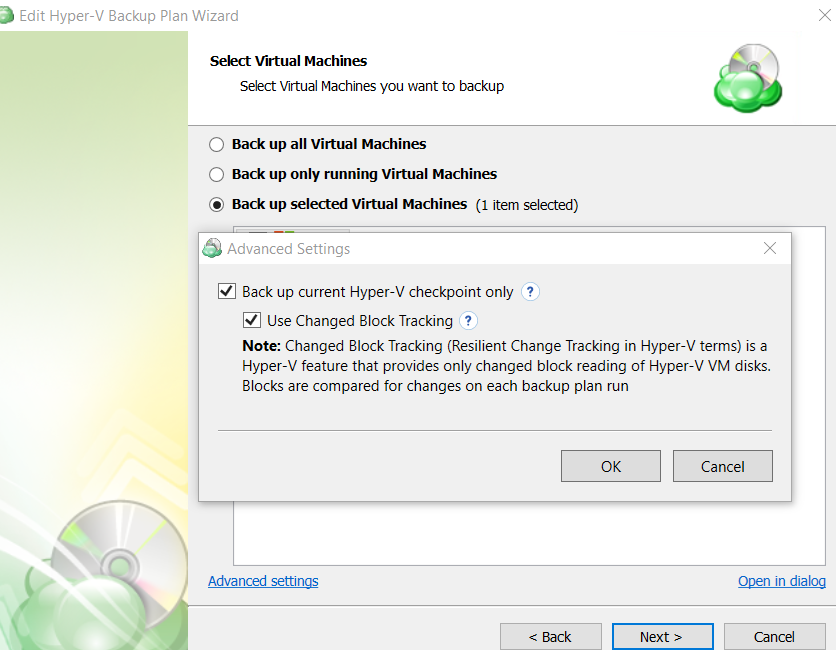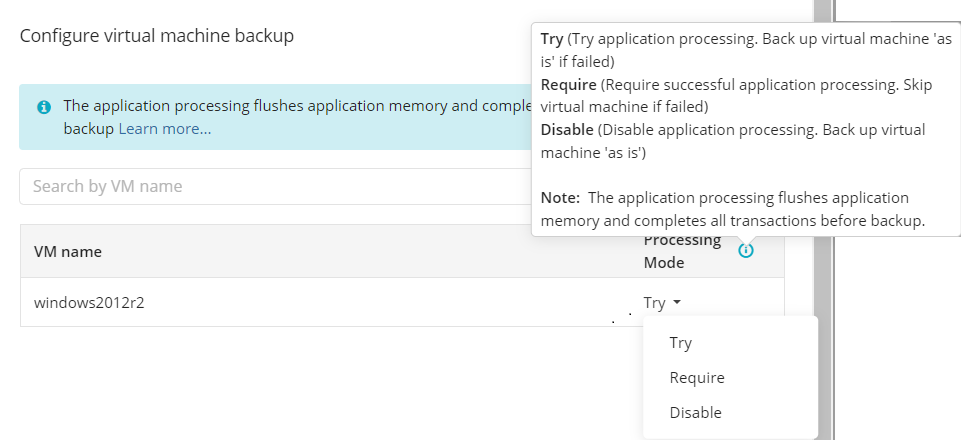Application-Consistent Backups
Application-consistent backups are used to back up entities with high or extremely high transaction loads. Good examples of such entities can be Microsoft SharePoint, Active Directory, MS SQL Server, Oracle database solutions, or any other.
Application-consistent backups are supported only on Windows Server 2016 and later.
When such high-transactional solutions are subject to backup, the key point is the memory state and current transactions are stopped, flushed to disk, and are included in the backup dataset.
In cases memory cannot be flushed to disk for some reason, a backup dataset may not be valid for restore or some important data may be missing.
Thus, an application-consistent backup is a backup that is equipped with tools to notify applications about coming backup operation and allow applications to achieve a quiescent and consistent state by flushing all operations to disk.
Frameworks for Application-Consistent Backups
Volume Shadow Copy Service (VSS) is a framework designed primarily to solve the application-consistent problems for Windows operating systems. VSS is an infrastructure that provides backup applications with the feature of creating application-consistent backups.
When a backup procedure is initiated, VSS works as follows:
- Every running application that needs to flush its data kept in RAM to disk is notified by VSS.
- Then a Copy-On-Write operation is performed on volume.
- A volume snapshot is done and can be processed by a backup application.
Available Hyper-V Checkpoint Types
Windows 10 Hyper-V includes two types of checkpoints:
- Standard Checkpoints. Standard checkpoint takes a snapshot of the virtual machine and virtual machine memory state at the time the checkpoint is initiated. A snapshot is not a full backup and can cause data consistency issues with systems that replicate data between different nodes such as Active Directory. Hyper-V only offered standard checkpoints (formerly called snapshots) prior to Windows 10
- Production Checkpoints. Production checkpoint uses Volume Shadow Copy Service or File System Freeze on a Linux virtual machine to create a data-consistent backup of the virtual machine. No snapshot of the virtual machine memory state is taken.
Checkpoint Creation
Checkpoint creation depends on Hyper-V configuration. The following cases are possible:
- Production checkpoint creation is enabled
- Standard checkpoint creation is enabled
- Checkpoints are disabled (no checkpoint type)
Changed Block Tracking (CBT) option defines the type of checkpoints the Hyper-V Backup plan will create.

If CBT is disabled, upon the start of the backup plan the application attempts to create a checkpoint of a type specified in the Hyper-V Manager.
If a Production/Standard checkpoint is not created, or checkpoints are disabled on the Hyper-V’s side, the further behavior will be determined by the Application Processing settings. This behavior is described in the "If CBT is enabled" section below.
By default, a Recovery Application Consistent checkpoint is created. When a Recovery Application Consistent checkpoint is created, the Hyper-V signals all the applications running on the corresponding VM to commit all RAM transactions to hard drives. A differential checkpoint of a hard drive will be created using the Volume Shadow Copy Service (VSS).
If the creation of a Recovery Application Consistent checkpoint fails, the Recovery Crash Consistent checkpoint will be created instead. The Recovery Crash Consistent checkpoint does not interact with the running applications, the RAM transactions will be lost, and a differential checkpoint of a hard drive will be created using VSS.
If CBT is enabled, the Backup plan will only create Recovery checkpoints. The further behavior depends on the Application Processing settings:

- Creates Recovery Application Consistent checkpoints. If failed, a Recovery Crash Consistent checkpoint will be created instead.
- Creates Recovery Application Consistent checkpoints. If failed, the VM will be skipped.
- Creates only Recovery Crash Consistent checkpoints.
For recovery consistent checkpoints, input/output activities that are quiesced in the moment of VSS snapshot creation will be resumed.
It is not recommended to use recovery inconsistent checkpoints for restore purposes: restore may fail
To learn how to configure checkpoints in Hyper-V Manager, refer to Using checkpoints to revert virtual machines to a previous state chapter at docs.microsoft.com
Configure Application-Consistent Backups (BETA)
You can configure the Application processing options after the Select Virtual Machines step of the Hyper-V backup wizard. These options can be configured separately for each virtual machine.

By default, the Try application processing setting is set. You can change it, if necessary.
The following options are available:
- Try application processing. Back up virtual machines 'as is' if failed. Once this option is selected, virtual machines are backed up one by one. The state of applications running on virtual machines is checked, then a recovery consistent checkpoint is made and an application-consistent backup is performed. In case an recovery consistent checkpoint cannot be not made for some reason, this virtual machine will be backed up 'as is'.
- Require successful application processing. Skip virtual machines if failed. Once this option is selected, virtual machines with applications that did not flush pending I/O operations from memory to disks, are skipped and an appropriate warning is displayed for a user.
- Disable application processing. Back up virtual machines 'as is'. Once this option is selected, regular VM snapshots are done without quiescing.
Upgrading to Version 7.9 from Previous Versions
If you have Hyper-V backup plans created in previous Backup Agent versions (7.8 or earlier), upon upgrade to the Backup Agent for Windows 7.9 or higher the new application-aware backup settings will be applied as follows:
- If the Quiesce guest file system option was enabled, after an upgrade to version 7.9 the Back up virtual machines with application-consistency issues option will be set
- If the Quiesce guest file system option was disabled, after an upgrade to version 7.9 the Do not use application-consistent backup option will be set
The Changed Block Tracking settings will be kept unchanged.